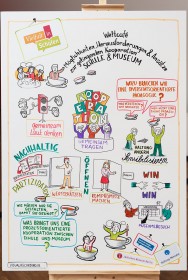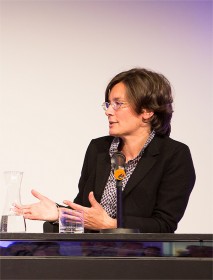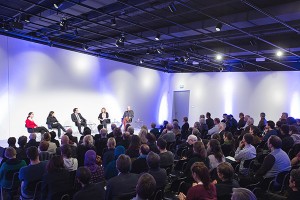
A “graphic recording” of the ways in which schools and museums can cooperate more closely on diversity issues © JMB, photo: Jule Roehr
We learned a lot in the course of our three-year “Vielfalt in Schulen” [ViS] program, which the Jewish Museum Berlin [JMB] carried out in cooperation with the Deutsche Kinder- und Jugendstiftung [DKJS, German Foundation for Children and Young People], with funding courtesy of the Stiftung Mercator [Mercator Foundation]. Journalist Alke Wierth of the national daily paper, tageszeitung, recently helped us weigh up the results.
Alke Wierth: Looking back on what you had in mind when launching the “ViS” program, can you recall at which point you first thought: “Things are not going the way we planned?”
Rosa Fava, project leader, JMB: It was right at the start, at one of the meetings with the participating schools, where we discussed their expectations of the program. A lot of the stuff talked about there made me wonder: What on earth has this to do with our concept?
For example?
→ continue reading

Dr. Karen Körber, the first scholar ever to benefit from the Fellowship Program of the Jewish Museum Berlin © JMB, Photo: Ernst Fesseler
The Jewish community in Germany has undergone a profound change in recent years—and the protagonists behind that change are the primary focus of research undertaken by Dr. Karen Körber, the first scholar of the Fellowship Program of the Jewish Museum Berlin. For the last two years Dr. Körber has been investigating “Daily Realities: Jewish Life in Germany Today” and she recently spoke to me about her findings.
Karen, the Fellowship Program of the JMB supports research into Jewish history and culture as well as into broader-ranging aspects of migration and diversity in Germany. You are the first person ever to complete the two-year Fellowship Program—a pioneer, so to speak—and I’d be interested to hear about that experience.
I found myself in a very open situation and was able to do much as I liked. All fellowship programs are fundamentally privileged set-ups but this particular one has the advantage of being attached to a well-endowed institution of international renown. → continue reading
Food for Thought from Our Recent Conference on “Migration and Integration Policy Today”
In the year 2000, the UN named 18 December International Migrants’ Day. Today, thirteen years later, Germany is well-established as a prime target country for migrants. Its population is plural, multi-religious, and multi-ethnic. Migration and integration therefore provide both politicians and academics considerable scope to tread new ground. But what state is migration and integration policy in today? And what role does academia play in shaping it? Which concepts have become obsolete, and which new perspectives are opening?

Panel discussion at the Academy of the Jewish Museum Berlin
© Jewish Museum Berlin, photo: Ernst Fesseler
On 22 November 2013, experts in migration research engaged in intensive and controversial debate of these questions at a conference jointly convened by the Jewish Museum Berlin, in the framework of its new “Migration and Diversity” program, and by the German “Rat für Migration,” a nationwide network of academics specialized in migration and integration issues. In the subsequent open forum with these invited guests, politics and science met head on: politicians and academics discussed, among others, migration policies proposed by Germany’s recently elected coalition government. → continue reading


